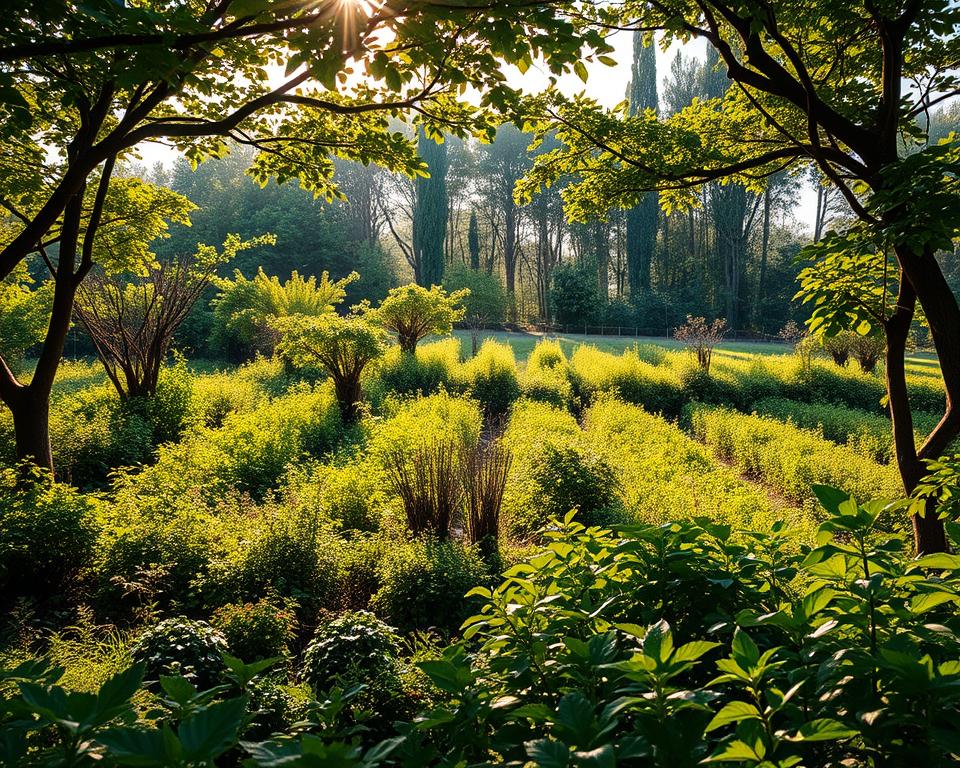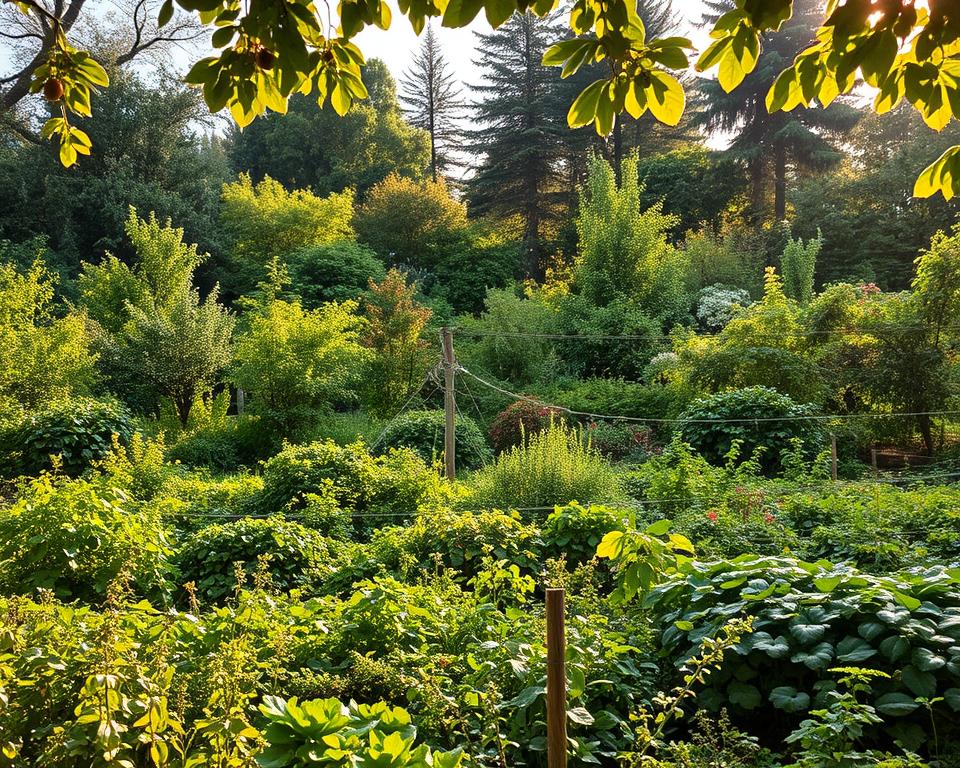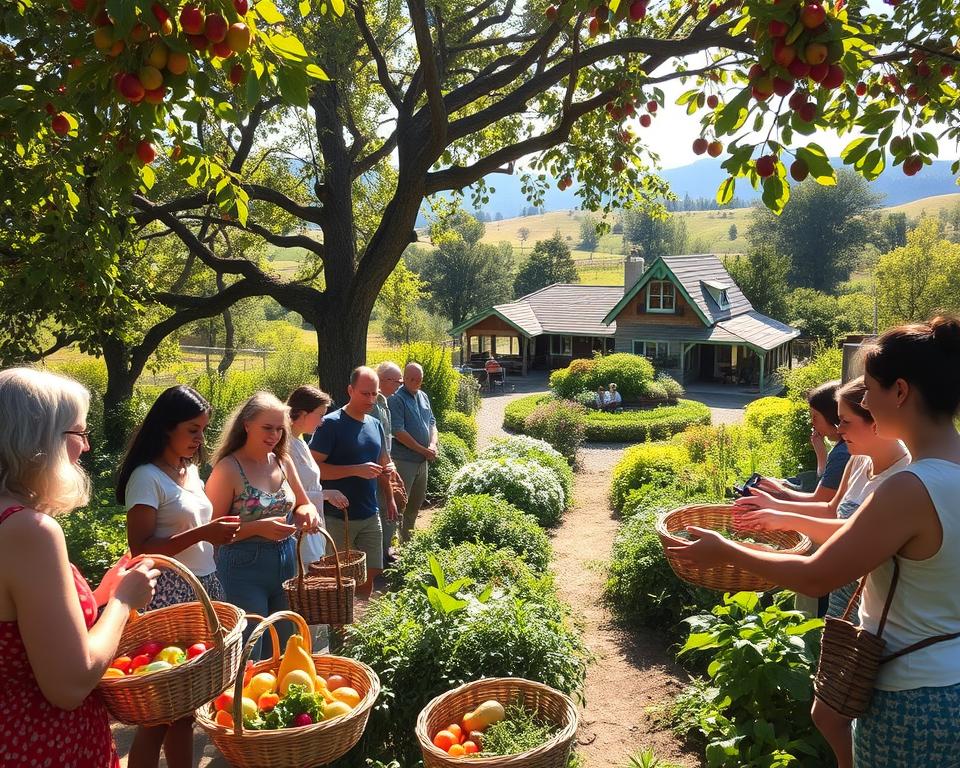A food forest is a low-maintenance permaculture design that mirrors nature’s systems. Unlike traditional gardening, it combines layers of plants like asparagus and artichokes, which thrive for years with minimal care. Forest gardening focuses on harmony between species, where trees like hazelnut and walnut form the canopy, while groundcovers like strawberries suppress weeds. This approach reduces reliance on chemicals like neonicotinoids, protecting pollinators.
Imagine a garden that feeds you for decades. Asparagus produces for ten years after three years of growth. Goji berries tower up to 12 feet, and salsify reseeds itself. These plants work together to create ecosystems that need no synthetic fertilizers. Courses like Verge Permaculture’s 6-week program teach how to design such systems, with sessions starting September 24 for just $290. Participants gain skills to build forests that balance productivity and ecology, like the Beacon Hill Food Forest in Seattle.
Key Takeaways
- Food forests reduce labor over time as plants like strawberries and nut trees mature.
- Permaculture design integrates layers from groundcovers to canopies, boosting biodiversity.
- Thousands have learned through courses, with free soil testing available in King County.
- Long-lived plants like asparagus and chestnuts cut replanting efforts.
- Urban areas, like those supported by the Urban Homestead Foundation, prove food forests work anywhere.
What is a Food Forest?
A food forest is an edible landscape that mirrors nature’s patterns. It differs from traditional gardens, being a self-sustaining ecosystem where plants collaborate to flourish with minimal human intervention. This method is rooted in sustainable agriculture principles, combining food production with environmental care.
Definition and Overview
“Food forests are a practice that integrates edible plants into forest ecosystems, a method used for centuries across cultures.”
These systems thrive through layered design, creating microclimates that support biodiversity. The seven core layers include:
| Layer | Description |
|---|---|
| Canopy | Large fruit trees like apples or chestnuts |
| Understory | Smaller trees (peaches, pears) thriving in partial shade |
| Vines | Grapes or kiwi climbing structures or trees |
| Shrubs | Blueberries or hazelnuts in shaded areas |
| Herbaceous | Perennials like comfrey or strawberries |
| Groundcover | Plants like clover suppressing weeds |
| Rhizosphere | Root crops (garlic, potatoes) improving soil |
Key Benefits of Food Forests
- Biodiversity: Supports pollinators and wildlife through varied plant layers.
- Low maintenance: Once established, requires less water and no synthetic chemicals.
- Climate resilience: Deep-rooted plants withstand droughts better than annual crops.
- Year-round yields: Mix of perennials and annuals provide food across seasons.
By mimicking nature, food forests reduce environmental impact while nurturing communities. They’re a win for both the planet and your plate!
Principles of Permaculture
The concepts of forest gardening are less about recreating a forest environment and more about producing food and resources in layered, self-sustaining systems.
Permaculture design transforms landscapes into thriving ecosystems through ethical and practical frameworks. These principles guide sustainable agriculture practices, ensuring edible landscapes function like natural habitats. At its core, permaculture design prioritizes resilience by mimicking nature’s patterns.
Understanding Permaculture Design
Permaculture design employs 12 foundational principles to create systems that nourish both people and the planet. Key ideas include observing natural cycles and stacking functions—like planting nitrogen-fixing shrubs that also deter pests. By integrating these strategies, gardens evolve into productive spaces that need less human intervention. For instance, mulching pathways reduces weeding while feeding soil life.
Ethical Guidelines of Permaculture
The three ethics—Earth Care, People Care, and Fair Share—form the backbone of every project. Earth Care means nurturing soil health through composting and biodiversity. People Care ensures spaces provide food and beauty, while Fair Share means sharing surplus with communities. These ethics turn permaculture design into a tool for sustainable agriculture, fostering landscapes that give back more than they take.
Zones and Sectors in Permaculture
Zones divide land by use frequency: Zone 1 (daily tasks) near homes, while Zones 2-3 hold food forests needing less frequent care. Sectors analyze sun angles, wind patterns, and water flow to place elements strategically. A U-shaped garden design, for example, traps heat for tender plants while aligning with natural edges.
By blending these strategies, even small yards can become vibrant edible landscapes that thrive with minimal effort. Every choice—from plant selection to water catchment—builds systems that adapt over time, mirroring nature’s wisdom.
Selecting the Right Site
Choosing the perfect spot for your food forest is crucial for success. Whether it’s a backyard or a community space, every detail matters. From sunlight to soil, each factor shapes your edible landscapes. A well-planned site ensures your food forest thrives, becoming a self-sustaining ecosystem rooted in permaculture design.
Factors to Consider for Location
Begin by sketching your space. Note the sunlight patterns and water flow. A small food forest might fit in 380’x80’ plots, but size varies based on your goals. Before digging, call 811 to check for utility lines. Observe:
- Sun patterns: Which areas stay bright vs. shady?
- Water flow: Does rain erode soil or collect in pools?
- Space: Leave room for trees to grow—canopy species can reach 50’ tall.
“Make a simple map and assess your site. Is it a backyard or side yard? Track light and water first.”
Soil Quality and Preparation
Healthy soil is essential for any food forest. Begin by sending a soil sample to a local lab (free in King County). Test pH and nutrients. If your soil is sandy, add compost to increase organic matter. Follow these steps:
- Test soil annually for pH and nutrient levels.
- Amend poor soil with compost—think “tons” for heavy sand or clay.
- Use sheet mulching to avoid tilling, protecting soil biology.
Ernst Götsch’s work in Brazil shows even degraded land can thrive. He boosted cocoa yields 3x using permaculture practices. Patience is key—trees take 3-5 years to mature. A well-prepared site saves time later. Sustainable agriculture begins here, turning your plot into a foundation for decades of harvests.
Planning Your Food Forest Layout
Designing your food forest layout begins with understanding plant interactions. Permaculture design principles guide this process, ensuring each layer has multiple functions. From towering trees to hidden root crops, every level contributes to a thriving ecosystem.
- Layer 1: Canopy – Choose fruit or nut trees like chestnuts or apples.
- Layer 2: Sub-canopy – Plant dwarf fruit trees or berry bushes.
- Layer 3: Shrubs – Use blueberries or elderberries for edible yields.
- Layer 4: Herbaceous – Include comfrey or borage for soil health.
- Layer 5: Ground covers – Clover or strawberries to suppress weeds.
- Layer 6: Rhizosphere – Plant Jerusalem artichokes or garlic for root depth diversity.
- Layer 7: Vines – Grow grapes or kiwi along structures to maximize space.
Companion Planting Strategies
View plants as teammates in forest gardening. Guilds are formed where each species benefits others. Clover fixes nitrogen, while marigolds deter pests. For small spaces, a 100-square foot area can host a fruit tree guild with herbs and flowers.
Avoid overcrowding by spacing plants according to their mature size. Mulch with 6-inch layers to retain moisture and suppress weeds.
Creating Wildlife Habitats
Invite birds and bees by adding birdbaths, native flowers, and insect hotels. A sustainable agriculture approach means tolerating some pest damage for pollination services. Prune shrubs to create nesting spots and leave leaf litter as habitat.
Remember, a biodiverse system with 400,000+ edible perennials options will naturally balance itself over time.
“A food forest isn’t just for humans—it’s a shared home for all life.”
By layering plants, fostering guilds, and inviting wildlife, your food forest becomes a self-sustaining network rooted in agroforestry principles. Start small, observe growth patterns, and let nature guide your design.
Choosing Plants for Your Food Forest
Creating an edible landscape begins with selecting the right plants. Opt for perennial plants such as asparagus and strawberries to save time and enhance biodiversity. Sustainable agriculture flourishes when native and non-invasive exotic plants coexist harmoniously.
“Work With What You Have and What Nature Brings. Many who are new to the concepts of forest gardening make the mistake of thinking that they need to begin by clearing a site and planting trees and shrubs. Often, we should first examine what we already have.”
Native species like wild garlic and elderberries support local pollinators. Combine them with non-natives like Japanese plums for increased yields. Be cautious of invasive exotics like kudzu and consult local extension services for safe alternatives.
| Plant | Type | Benefits |
|---|---|---|
| Wild garlic | Perennial herb | Self-seeds, thrives in shady spots |
| Rhubarb | Perennial vegetable | Hardy, produces for decades |
| Elderberry | Shrub | Edible berries, attracts pollinators |
| Nettles | Perennial green | Edible leaves, enrich compost |
| Alpine strawberry | Perennial fruit | Sweet berries, spreads gently |
| Hazelnut | Tree | Edible nuts, fixes nitrogen |
Balance your food forest with a mix of perennials and annuals. Annuals like beans fill gaps while young trees grow. Aim for 80% perennials for a low-maintenance, high-yield garden.
Edible landscapes combine aesthetics with utility. Blend blueberries with serviceberries for continuous interest. Focus on plants like salsify or sorrel that thrive without synthetic fertilizers.
Designing for Biodiversity
“A food forest mimics natural forest ecosystems, resulting in better yield and less maintenance.”
Biodiversity is the cornerstone of a thriving food forest. By integrating plants and wildlife, these systems become self-sustaining ecosystems. They resist pests and adapt to climate changes. Every species, from towering trees to soil fungi, plays a crucial role in achieving balance.
Soil thrives when layers work together. The seven main layers of a food forest include:
| Layer | Examples | Role |
|---|---|---|
| Canopy | Apple, walnut | Provide shade and carbon sequestration |
| Understory | Cherry, plum | Yield fruit while sharing space |
| Shrub | Blueberry, hazelnut | Attract pollinators and stabilize soil |
| Herb | Comfrey, chamomile | Suppress weeds and fix nutrients |
| Groundcover | Strawberry, clover | Prevent erosion and retain moisture |
| Vines | Kiwi, grapes | Use vertical space for yield and shade |
| Root | Garlic, potatoes | Enhance soil structure without disturbing upper layers |
Wildlife corridors link your food forest to nearby habitats. Native plants like milkweed support monarch butterflies, while log piles shelter predators like ladybugs that eat aphids. Even small elements like a brush pile or a bee hotel boost biodiversity, turning your garden into a hub of sustainable agriculture.
Over time, this interconnected web of life builds a resilient food forest. It feeds both people and the planet.
Maintenance Practices
Effective maintenance ensures your food forest thrives with minimal effort. Begin by observing plant behavior. Wilting leaves or insect swarms indicate the need for adjustments. Early permaculture design reduces long-term work. Follow this guide for long-term success:
Pruning and Monitoring Growth
- Prune broken branches after winter storms to prevent disease spread
- Strategic pruning of moringa trees every 6 weeks boosts foliage yield
- Use mulch pathways to keep garden beds accessible year-round
| Plant Species | Pruning Priority |
|---|---|
| Moringa | 3 (critical) |
| Mulberry | 3 (critical) |
| Elderberry | 2 (moderate) |
| Cassava | 1 (minimal) |
Sustainable Pest Management
Encourage biodiversity by planting milkweed to support monarch butterflies. Integrated pest management uses natural predators like ladybugs for aphids. Accept minor pest damage as part of ecosystem balance—90% of insects in healthy food forests are non-destructive.
Seasonal Care Tasks
| Season | Key Tasks |
|---|---|
| Spring | Weed early; mulch paths; plant mushroom logs |
| Summer | Check for drought stress; harvest berries |
| Fall | Fertilize berry bushes with compost; prepare soil |
| Winter | Prune dormant trees; plan for next season |
Annual mulch applications and seasonal pruning schedules reduce long-term labor. Well-designed forest gardening systems require just 3-7 hours weekly once established. Let natural processes guide your interventions—less is more when nurturing self-sustaining ecosystems.
Harvesting and Sharing Your Bounty
“Grow food and share it! Even if you just plant some lettuce in a window box, the act of growing wholesome food connects us to generative living.”
Harvesting a food forest is a celebration of patience. Unlike conventional gardens, edible landscapes yield crops year-round from multiple layers—fruit trees, berries, herbs, and ground covers. Timing matters: check plants weekly as seasons shift. Ripeness varies—berries blush first, while nuts signal readiness with cracked hulls. Record harvest dates annually to refine future efforts.
- Use sharp shears to pick fruits without damaging stems
- Rotate harvest zones to avoid over-picking one area
- Leave a few fruits on trees to seed natural regeneration
Sharing surplus builds community. The Project Food Forest initiative, launched in 2016, turned public spaces into edible landscapes where neighbors gather crops together. A 2,000-year-old food forest in Morocco still thrives, proving that forest gardening sustains both people and ecosystems. Excess produce can fill local food pantries or inspire harvest festivals.
Turn abundance into action: host workshops to teach neighbors how to preserve plums into jam or dry herbs. Even small sustainable agriculture efforts—like donating zucchini to schools—create ripples. Remember: the third year yields visible growth, but the real harvest is connection. Every shared tomato builds a stronger, nourished community.
Case Studies of Successful Food Forests
Communities across the U.S. are proving food forests can thrive anywhere. Here’s how real-world projects turned permaculture design into tangible results.
“If you’re in Seattle, definitely visit the Beacon Hill Food Forest, and consider volunteering. The Urban Homestead Foundation will be a groundbreaking way to introduce generative living in urban areas.”
Notable Examples Across the U.S.
- Beacon Food Forest (Seattle): 7 acres of public land now grows community crops using agroforestry principles.
- Mother of Peace (Alabama): Surplus produce sold at farmers markets since 2019.
- Prairie Ally (Minnesota: Expanding to two new food forests in 2023, blending permaculture design with local needs.
Lessons Learned from Food Forest Projects
Key takeaways from pioneers include:
- Plan for growth: Avoid overcrowding by spacing plants for their mature size. One project’s apple trees overcrowded a 0.5-acre plot, reducing yields.
- Community first: The Beacon project’s volunteer network ensures long-term care. Sustainable agriculture thrives when neighbors take ownership.
- Be patient: Den Bosch in the Netherlands took 3 years to break even financially. Early focus on biodiversity boosted long-term yields.
These stories show food forests aren’t just gardens—they’re living labs for sustainable agriculture. Every project proves creativity and patience make permaculture design possible anywhere.
Getting Involved in the Movement
Joining the food forest movement connects you with a network of growers, designers, and communities. Explore success stories like Seattle’s Beacon Food Forest, a 7-acre project that sparked global interest. Asheville’s Dr. George Washington Carver Edible Park, now in its 25th year, also showcases the power of permaculture design.
These examples demonstrate how urban spaces can be transformed into thriving ecosystems. They inspire us to create our own food forests.
Resources for Aspiring Food Forest Creators
Start with books like Edible Forest Gardens by Dave Jacke and Eric Toensmeier. Online platforms like the Permaculture Women Guild are also valuable resources. The Permaculture Institute offers certified courses in agroforestry.
The USDA’s Sustainable Agriculture Research and Education program provides grants for community projects. Nurseries like Raintree Nursery and Nativescape offer plants for food forest layers. Seed banks like Seed Savers Exchange preserve heirloom varieties.
Community Programs and Workshops
Local groups like the Beacon Food Forest host monthly workdays. Volunteers gain experience in pruning and pest management. The Seattle Farm School’s seed-lending library and gardening classes teach sustainable agriculture skills.
In Bloomington, the Sherrett Food Forest’s CSA program accepts SNAP benefits. This shows how food forests can address accessibility. Attend events like the annual Midwest Permaculture Convergence to network and learn from projects like Basalt Food Park’s partnership-driven model.
FAQ
What exactly is a food forest?
How do food forests differ from traditional gardens or orchards?
What are the main benefits of establishing a food forest?
How does permaculture design inform food forests?
What ethical guidelines should be considered in food forest design?
What factors should be considered when selecting a site for a food forest?
How can I choose the right plants for my food forest?
What strategies can enhance biodiversity in my food forest?
How do I maintain my food forest once established?
How can I efficiently harvest and share surplus from my food forest?
Where can I learn more about successful food forest initiatives?

Daniel Harrysson is a writer at InfoTrendor, specializing in organic farming, permaculture, and sustainable living. With a deep commitment to eco-conscious practices, he explores topics such as regenerative agriculture, self-sufficient systems, and environmental conservation. His goal is to provide readers with practical insights and innovative solutions to help create a more sustainable and resilient future.



